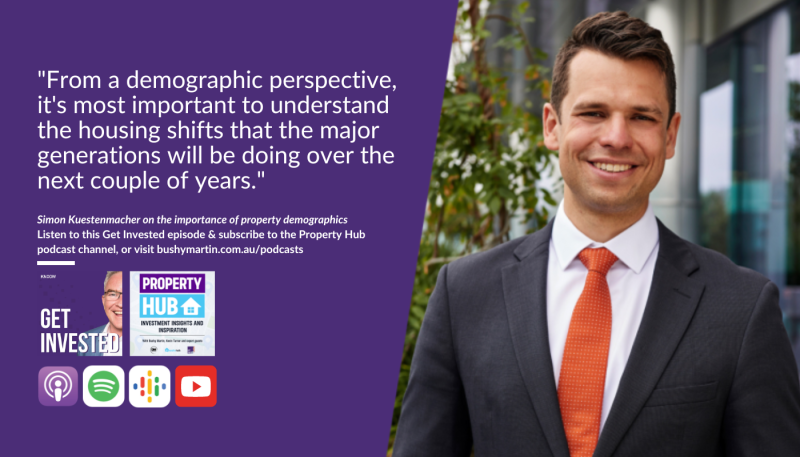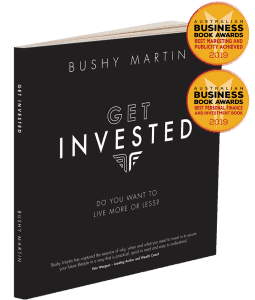Simon Kuestenmacher says property investors must be be on top of Australia’s evolving demographics to be successful in the years ahead.
Simon is the Co-Founder of The Demographics Group, providing specialist advice and insights on demographic, consumer and social trends.
On Property Hub’s Get Invested podcast, he joined Bushy to talk about emerging demographic trends, the influence they’re having on Australian property, and how investors can use this information to make the right decisions.
How are migrants influencing Australian housing?
The demographic of migrants coming into Australia now will change the type of housing features we see in the market.
“Back in the fifties and sixties when the migrants came from Europe, they overwhelmingly came from Mediterranean countries. So their housing preferences dominated. But now there are no more young people in Italy or Greece, and so now we will have decades on decades of Asian migration, and increasingly more Indian rather than say Chinese,” he said.
“So what kind of houses do Indian and Chinese migrants traditionally want? So I would say from the Chinese market, if I was to develop or build houses, I would make sure that they at least don’t commit any feng shui. Now, Western consumers will not notice this at all, but make sure that’s a thing.”
What changes come from an ageing population?
An ageing population means more consideration needs to go into the accessibility of different areas within the house, especially bathrooms. Ideally, these adaptations need to be implemented during the initial building process of all future houses.
“We also know that we’re ageing. So when going to build the bathroom doors, always make sure that they’re wide enough for wheelchairs to fit through. It’s simple stuff like this. If you build a house, it comes at almost no cost. If you need to retrofit 12 doors in your house, it’s expensive. You get those things from the get go. We might even integrate them into building standards because we want to minimise this. And even if we had the money, even if we didn’t care about the additional environmental costs of retrofitting all of those doors, do we have the labour force to do so?” Simon said.
“We tended to build relatively poor housing stock in the last couple of decades, meaning if you knock down the quarter acre block and you build four to eight townhouses on it, they have a life expectancy of 30 to 35 years. Environmentally, that’s probably not the smartest way to go about it. So think about this when you invest. Think about, how long is this thing going to be standing upright and what kind of future does it have? Will major overhauls need to be done down the track, because if so, that’s expensive.”
What demographic data indicators should you consider?
Some of the data points investors should investigate include geographies, housing types and growing cohorts.
“So the big housing types are three and four bedrooms, and as long as they are in extreme commutable distance to the CBD, say a two hour drive time radius around the CBD of our big cities, they will be in demand. That’s the most simplistic thing,” Simon said.
“You should then, of course, have an understanding of ‘which are the growing cohorts?’ Well, the fastest growing cohort are actually highly-skilled, dual-income millennial households. So what might an attractive house look like for a sophisticated couple where both parents work? It’s the biggest growth cohort.
“Then, if you look at the the newly arrived migrants, they will want inner city. They will want to afford commutes because they don’t know anything else. And so you create clustering effects. We call them launchpad suburbs. So in the inner city of every city, you’ll find suburbs where people go. And at the moment it’s simply newly-arrived migrants. Then once a migrant has been in Australia for long enough for five, six, seven, eight years, then they start behaving in the housing market just like everyone else with their income.
“Remember we do not segregate Australian cities based on sexual preference or ethnicity anymore. We exclusively segregate based on socio-economic spending power.”
What can we expect in the future?
From a demographic perspective, Simon said it’s important to understand the housing shifts that the major generations will be doing over the next few years, from pre-boomers to Gen X to millennials. This will ultimately guide investing decisions and timelines.
For example, an analysis of the baby boomers showed that the property market will truly come alive in the 2030s.
“So the baby boomers, born in the 18 years following the end of the Second World War, are a big cohort. They live overwhelmingly in the middle suburbs of our capital cities in three and four bedroom homes. They are too young, too agile and too healthy in the 2020s to be needing to downsize, so they don’t have the motivation to downsize. At scale, the baby boomers will stay put over the coming decade. Their goal is to stay living independently in their home for as long as possible,” he said.
“So they will look at home renovations, retrofitting, making sure that everything is perfectly level and they will lead to the biggest boom that you’ve ever seen in retrofitting lifts on the outside or inside of a house. So they will stay fit and stay put because they will work longer. They slide into retirement, and many still consult well into the seventies, so they have no motivation to sell the house that is in commuting distance to the CBD because they are still going there occasionally. And now their millennial kids would have made babies., and so they definitely need one or two spare bedrooms, so that the kids and their grandkids can visit.
“So all the baby boomer properties will enter the housing market in 2030, and I believe that will be the absolute wildest decade the Australian housing market has ever seen. So if you’re in the investing property game, don’t quit before the end of the 2020s. That’s when things get really wild.”
Listen to the full interview here.
Want to Know How you can build wealth with the help of leading, qualified experts? Check us out and talk to the team, now.




